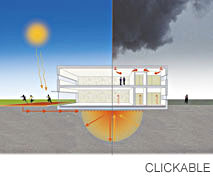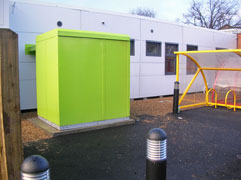Articles
What is District Heating?
District heating is a system for distributing heat between residential and commercial buildings using water in piped networks.
What are the advantages of distributing heat between buildings instead of each building generating its own heating?
In theory district heating plants can provide higher efficiencies and lower carbon emissions than local gas boilers.
The standard approach is to employ a gas-based combined heat and power engine to generate electricity at a central location and recycle the heat from cooling the engine to heat local buildings. This may be efficient in winter when heat is required: it can save energy and reduces carbon emissions compared to a remote gas-powered generating station which wastes all spare heat to the atmosphere to avoid overheating.
However, there is a much more direct way to reduce carbon emissions: stop using combustion altogether. Heating can be provided by heat pumps in each building which draw heat from a communal district network providing water at ground temperature.
Cooling is not normally provided by a district heating network. However, cooling is a requirement for most new office buildings in the south east of England and cooling can be provided by heat pumps in each building rejecting heat to the communal district network. This is more efficient than chillers trying to waste heat into hot air – when they can more easily reject heat to a cold groundwater circuit. A further bonus is that this increases the district network temperature for those buildings which need heating.
Novel approach to district heating
This novel approach to district heating and cooling has many advantages. It can ensure that building groups have a reliable, independent and sustainable source of Renewable Heating and Renewable Cooling.
Heat Sharing Networks can also bring On-site Renewable Energy to district heating, instead of relying on imported fossil fuel supplies commonly used in Combined Heat and Power (CHP) systems.
District Heating based on Heat Transfer and Heat Sharing Networks can ...
- provide a reliable and low-cost green energy source for space heating and cooling
- save over 70% on carbon emissions on heating compared to emissions from gas boilers
- save over 80% on carbon emissions on cooling buildings compared to emissions (from the power stations) that power electric air conditioning and electric chillers
- save 100% on carbon emissions on heating and cooling when the grid is decarbonised
- provide a low-cost heat energy (or cooling) source for industrial processes
- provide opportunities for reducing carbon emissions by re-cycling solar energy instead of burning fossil fuels
- provide the opportunity to recover heat from buildings with high occupancy and high passive heat gains and transfer it to buildings needing heat
- attract Renewable Heat Incentive for use of ground source heat pumps
- attract Renewable Heat Incentive for use of solar thermal collectors
- improve urban air quality by avoiding combustion of fossil fuels or biomass in densely populated areas
Groups of Buildings
A Heat Sharing Network is very well suited to providing District Heating to groups of houses. The cost of providing an efficient installation can be shared across a number of houses, and the benefits increase if the district heating system includes other buildings such as schools or offices whose heating and cooling requirements may follow a different daily pattern (and different weekly pattern) from the heating demand for houses.
Where the district covers offices, or data centres, the heat recovered from cooling these buildings can be transferred to homes requiring heating (or other buildings with a heating need such as a community swimming pool). Where the cooling demand is separated in time from the heating demand, surplus heat can be stored in ThermalBanks from the time it is available to the time it is needed. This efficient use of heat is at the heart of Interseasonal Heat Transfer and enables ICAX to provide cheaper heating and cheaper cooling than conventional methods, as well as proving heating and cooling with a very low carbon footprint.
Sharing heat between buildings
Many buildings have an overall cooling load over the year: they have a requirement to disperse heat. This often applies to modern office buildings in south east England with extensive glazing and high solar gains. These buildings may be adjacent to older buildings with an overall annual heating load.
ICAX has developed systems to allow for the transfer of heat between buildings: this form of heat transfer can save fuel and carbon emissions for both buildings on a "Heat Sharing Network".
Both buildings can benefit from a heat sharing dividend when they enjoy joined-up heating and cooling.
Other buildings with a need to loose excess heat include underground train tunnels, data centres and supermarkets.



